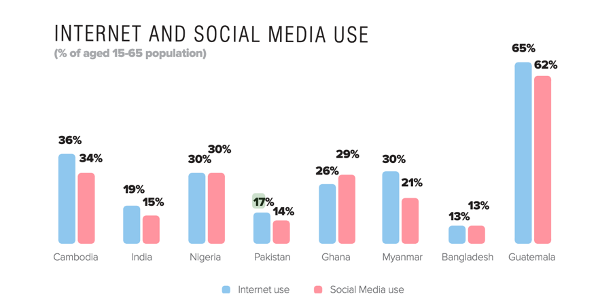
From business, education, health and research, to governance and (cyber)war, the Internet has become the backbone infrastructure that shapes and influences every sphere of life. And yet, so much of its use and access remains vague, particularly in economies such as Pakistan.
While there has been a huge adoption in mobile phone use with a large-scale demand for Internet services, there are a lot of factors that pose challenges towards its scalability and access, which I focus on in this post.
Access, relevance and security are major challenges facing the Internet in Pakistan
Pakistan has always ranked low on international scorecards for providing Internet access. According to the Economist Intelligence Unit’s Inclusive Internet Index for 2020, Pakistan is ranked 76th out of 100 economies. Commissioned each year by Facebook, the ranking considers four major dimensions: availability, affordability, relevance and readiness.
Availability examines the quality and extensiveness of the required Internet infrastructure for access and usage, for which the economy is ranked 86th out of 100. It scores slightly better for readiness (required skills, policies and cultural acceptance) and relevance (the levels of local content that exists) ranking 64th and 71st respectively.
In terms of affordability, which measures the cost of access and competition in the Internet market, it performed comparatively well by ranking 57th, with broadband plans starting from around USD 1.20.
For Pakistan to improve its ranking, it needs to overcome a number of challenges, starting with reducing the gap between rural vs. urban accessibility and with its adoption as well as:
- A lack of knowledge about the Internet: According to a report published by Bytes for All, Pakistan, 37% of those aged 15 to 65 know about the Internet, and 17% of the population use the Internet, with only 14% on social media. Although there is huge adoption of mobile phones, a vast percentage of the population still don’t own or have access to Internet-enabled phones. Other important factors are a low literacy rate and limited content available in local languages, both of which make people reluctant to use the Internet.

- A high gender gap: As the report by Bytes for All states, only 21% of males and 12% of females in Pakistan are online with an equal disparity among those that use mobile phones. This is almost on par with recent global figures that suggest that more than 300 million fewer women access the Internet on a mobile device than men, and women are 8% less likely than men to own a mobile phone. This poses a major challenge towards Internet adoption in general.
- Cybercrime and privacy Issues: Despite the critical role the Internet plays in the economy’s development and growth, there are still security and privacy concerns associated with it that pose a major challenge towards its access and adoption. Online harassment, fraud, cyberbullying, scams, blackmailing and hacking are becoming common threats for an individual, with a rise in the percentages of each every year. With a lack of policies, laws, awareness, specialized tools and skilled human resources to confront the threats imposed by cybercrime we have a long way to go before improving on our 7th ranking in economies with the worst cybersecurity.
Will new initiatives overcome these challenges?
Launched late last year, the Digital Pakistan Initiative seeks to expand on previous policies by enhancing connectivity, improving digital infrastructure, investing in digital skills and literacy, and promoting innovation and entrepreneurship.
One of the major goals of the Initiative is to use the potential of 170 million mobile users, 75 million broadband users and 25 thousand IT graduates within a year. Such goals are ambitious, and will have to overcome some major challenges such as policy-making gaps, limited digital services and different environmental barriers.
Another notable initiative the economy has adopted and maintained is the Universal Service Fund (USF), which operates under the Ministry of Information Technology. It aims to support telcos in developing and expanding their networks to rural areas not yet serviced.
So far the USF has successfully supported 3G/4G Internet access to 7,771 remote districts with 470,520 broadband connections. USF is also working to provide Internet access through its Broadband for Sustainable Development Program for the war-torn Federally Administered Tribal Areas (FATA).
Whether this access has led to greater adoption of the Internet, and the social and economic benefits the government hopes it will provide, is hard to say at this early stage. But I, along with the rest of the industry am sure, and hope, that these impacts are measured to allow for future initiatives to meet the challenges.
Ayesha Iftikhar is an Assistant Professor in the Department of IT at Balochistan University of Information Technology, Engineering and Management Sciences (BUITEMS).
The views expressed by the authors of this blog are their own and do not necessarily reflect the views of APNIC. Please note a Code of Conduct applies to this blog.

Covid-19 has presented challenges as well as opportunities, but there hasn’t been any specific or special package for IT and telecom in recent budget, Infact it has been reduced by 9%.
Revenue generation through exports is the only way out in this situation, looking forward to see how figures jump up keeping the ‘businesses go digital” shift, only if “government” ENVISIONS!
It’s a great article stating the landscape details, dilemma, and current stats of Pakistan’s internet landscape.
Here’s another great piece I have written more critically on the topic with keeping the security aspect in mind.
https://shahrukhathar.info/cyber-threat-landscape-and-readiness-challenge-of-pakistan/